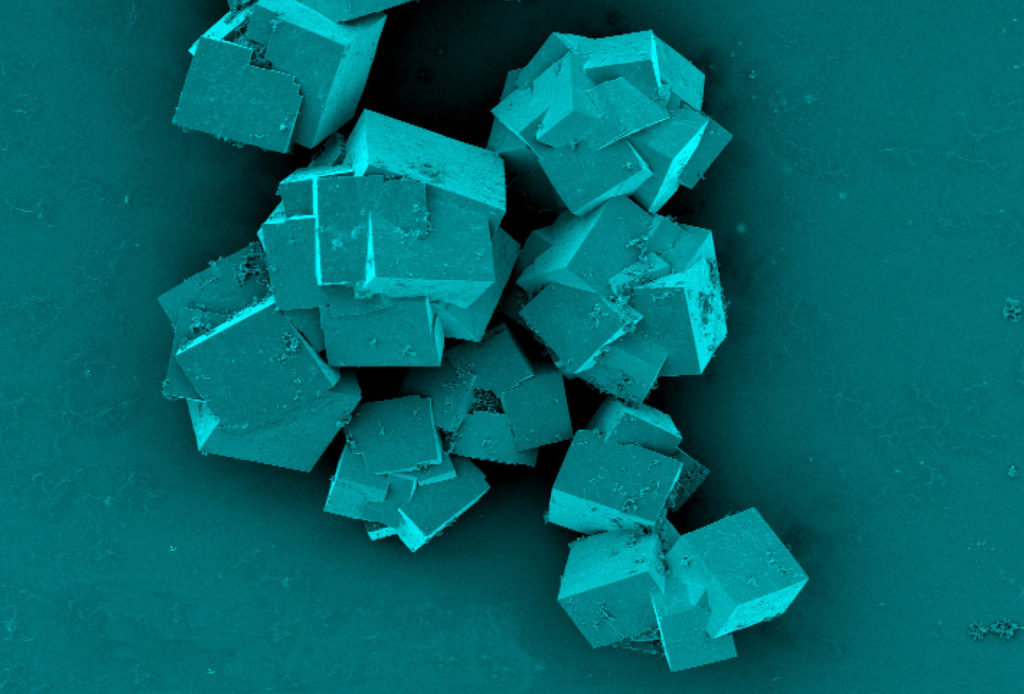
A new breakthrough could provide clean drinking water for people who don’t have that basic necessity.
Can you imagine not being able to go to the tap and pour yourself a glass of clean water to drink? Unfortunately that is the reality for almost a third of the world’s population. Some 2.1 billion people don’t have clean and safe drinking water. As a result, millions– mostly children – die from diseases associated with inadequate water supply, sanitation and hygiene every year.
Contaminated water transmits diseases such diarrhoea, cholera, dysentery, typhoid, and polio. And as the world’s population grows and clean water becomes scarcer, these issues will only increase.
In a revolutionary breakthrough, a team of researchers have come up with a method to turn sea water into safe drinking water in a way that’s more energy efficient, economically sustainable and cost effective than current technologies.
Mighty MOFs

MOFs: tiny crystals with big applications
It all comes down to MOFs. Metal-Organic Frameworks (MOFs) are an amazing next generation material that have the largest internal surface area of any known substance. The sponge like crystals can be used to capture, store and release chemical compounds. In this case, the salt in sea water.
A just released paper found that membranes made out of MOFs can mimic the way cells allow specific atoms or molecules through to help them grow and survive, while stopping everything else. Known as “selective permeability” this allows cells – and now MOFs – to act as a filter.
At the moment more than half the world’s desalination is achieved using a form of this called reverse osmosis, which is also an important step in most water treatment processes. There’s a downside though. Reverse osmosis membranes are inefficient, expensive and very energy intensive. A high flow rate, lots of pressure and energy need to be generated to “push” water through the membrane while leaving contaminants behind. Doing so can also create vast amounts of waste water, full of contaminants, and strip healthy minerals from the water along with the contaminants.
Specially-designed MOFs however, can potentially do the same thing with a far simpler membrane that requires vastly less energy. That’s because, unlike reverse osmosis, MOFs don’t need to create an artificial difference in pressure to “force” water through, while blocking contaminants. Instead, MOFs’ selective permeability means they’re designed at the molecular level to only let water pass.
Battery bonus

Could sea water one day power your phone? Image: Flickr / Martin Abegglen
If that wasn’t enough of a problem solver for you, MOFs technology could also help power your smart phone or other electrical equipment one day.
The research found MOFs are great at extracting the Lithium used in today’s highly popular Lithium Ion batteries. When it comes to natural resources most people think of huge underground or open cut mines. Lithium though has, for decades, been extracted from extremely salty water known as brine using expensive chemical processes.
This MOFs breakthrough means it could be possible to extract Lithium cheaply from the planet’s abundant and easily accessed supplies of sea water instead.
There are other advantages as well. Waste water from industrial processes could be purified, reducing pollution while, at the same time, extracting Lithium and other resources for resale.
The research team made up of our very own chief scientist, Dr Anita Hill, and researchers from Monash University and the University of Texas at Austin worked together to try and solve this global challenge.
So there you have it. MOFs could soon be doing everything from providing safe drinking water around the world to powering your smart phone and helping reduce pollution.


16th February 2018 at 3:22 pm
Ships that are nearing their use by date could be used as platforms to build a Thorium Reactor to power a desalination plant. The ship can be moored in a port that is experiencing drought, desalinate sea water from the harbour and pump fresh water into the town’s water mains. The salt that is recovered is a valuable commodity and can be on sold to industry. Thorium reactors do not produce radioactive waste. They can actually be used to process it and render it harmless. Thorium is found in clay and we have plenty of that. When the drought breaks the ship can be moved to another port where drought is being experienced.
16th February 2018 at 3:20 pm
Zeolites were once considered to offer the filtering potential now possible from MOFs, so it will be interesting and hopefully exciting to see how artificially-made materials can remove the limitations inherent within zeolites and take filtering to a new level
16th February 2018 at 3:17 pm
Ellen, looking at the abstract of the article you referenced it is clear this technology has applications in treating waste water from mining operations. I work a lot in Bolivia where acidic mine waste water causes huge environmental damage. The technology presumably won’t fix the high acidity but seems as though it will strip out all the salt and toxic heavy metals. Has the technology been commercialised yet?
12th February 2018 at 9:37 pm
There are many metals in sea water Are MOFs partial to lithiml or can they be tuned to select any metal?
16th February 2018 at 1:33 pm
Hey Stephen,
There are a number of metal ions found in sea water. The MOF we are talking about has great performance (speed and selectivity) for some of them. I imagine that we could screen MOFs in the computer to see which MOFs are best suited for extraction of the metals of interest. For example, we have done work on extraction of heavy metal ions from water and this can be found at http://pubs.rsc.org/-/content/articlehtml/2015/ta/c5ta04154f
We hope this helps!
Cheers,
Ellen
CSIRO Social Media
12th February 2018 at 11:40 am
At last we have found a replacement for our oft complained about desalination plant.